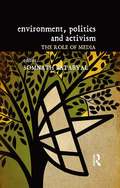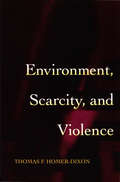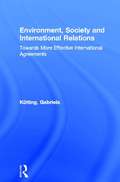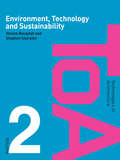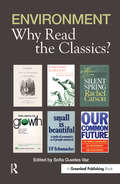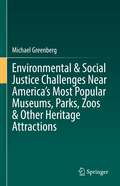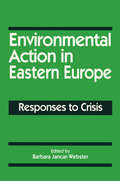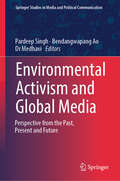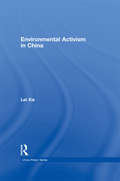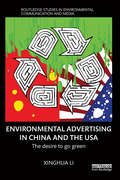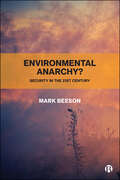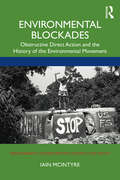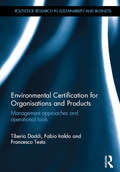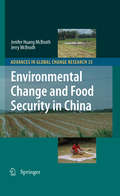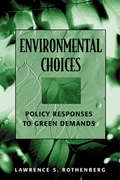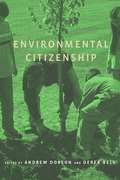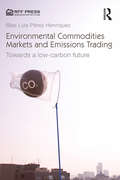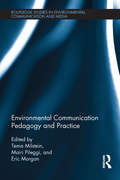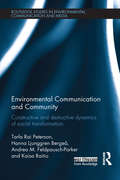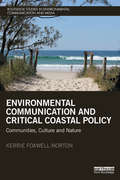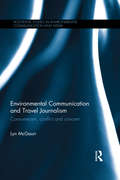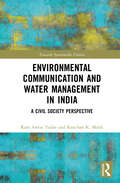- Table View
- List View
Environment, Politics and Activism: The Role of Media
by Somnath BatabyalThis book examines the role of the media in environmental politics and activism in the 21st century. It highlights how politics is mediated in myriad ways through newspapers and news channels, through mobile telephony and through social networking sites. Further, it shows how the media creates and influences relevant discourses, builds campaigns and awareness, and adopts and discards issues. With a range of perspectives on issues of environmental justice and equity, the volume scrutinizes how the media discourse on environment shapes our politics, and the role of international politics, finance, youth, newspapers, magazines and 24-hour television. Bringing together academics, activists and media persons, this highly topical book will serve as significant reading for researchers and scholars of development studies and media studies, as well as policymakers, NGOs and environmental campaigners.
Environment, Scarcity, and Violence
by Thomas F. Homer-DixonThe Earth's human population is expected to pass eight billion by the year 2025, while rapid growth in the global economy will spur ever increasing demands for natural resources. The world will consequently face growing scarcities of such vital renewable resources as cropland, fresh water, and forests. Thomas Homer-Dixon argues in this sobering book that these environmental scarcities will have profound social consequences--contributing to insurrections, ethnic clashes, urban unrest, and other forms of civil violence, especially in the developing world. Homer-Dixon synthesizes work from a wide range of international research projects to develop a detailed model of the sources of environmental scarcity. He refers to water shortages in China, population growth in sub-Saharan Africa, and land distribution in Mexico, for example, to show that scarcities stem from the degradation and depletion of renewable resources, the increased demand for these resources, and/or their unequal distribution. He shows that these scarcities can lead to deepened poverty, large-scale migrations, sharpened social cleavages, and weakened institutions. And he describes the kinds of violence that can result from these social effects, arguing that conflicts in Chiapas, Mexico and ongoing turmoil in many African and Asian countries, for instance, are already partly a consequence of scarcity. Homer-Dixon is careful to point out that the effects of environmental scarcity are indirect and act in combination with other social, political, and economic stresses. He also acknowledges that human ingenuity can reduce the likelihood of conflict, particularly in countries with efficient markets, capable states, and an educated populace. But he argues that the violent consequences of scarcity should not be underestimated--especially when about half the world's population depends directly on local renewables for their day-to-day well-being. In the next decades, he writes, growing scarcities will affect billions of people with unprecedented severity and at an unparalleled scale and pace. Clearly written and forcefully argued, this book will become the standard work on the complex relationship between environmental scarcities and human violence.
Environment, Society and International Relations: Towards More Effective International Agreements
by Gabriela KüttingWritten in an accessible and lively style, this ground-breaking text marries a critique of current remedies towards environmental problems to original and viable alternatives. This text adopts an eco-centric rather than a traditional environmental management perspective to focuses on the key issues such as: * The effectiveness of international agreements in solving environmental problems * the role of the structures and constraints within which these agreements operate
Environment, Technology and Sustainability (Technologies of Architecture)
by Hocine Bougdah Stephen SharplesThis second volume in the Technologies of Architecture series – the only series of books tuned to the architectural technology syllabus – explores the environmental influences on building design. Looking particularly at sustainable building, a holistic view is taken, so that the influence of any one set of choices on other areas – such as the trade-off of daylighting against thermal insulation, or the balance needed between heating and ventilation – are not overlooked. The authors discuss available technologies for establishing a suitable microclimate within buildings, for managing the transmission of sound and for minimizing the exploitation of scarce energy and of other resources. Using the perspective of a designer who needs a sound scientific basis for arriving at the optimum outcome, this valuably informative volume is ideal for architectural technology students, as well as first and second year architecture students.
Environment: Why Read The Classics?
by Sofia Guedes VazEnvironment: Why Read the Classics? presents six important essays by some of the world's leading environmental thinkers on six of the most emblematic books ever written on the environment. The books – Walden; A Sand County Almanac; Small is Beautiful; Silent Spring; The Limits to Growth; and Our Common Future – taken together have been hugely important in the development of global environmental awareness, activism and policy. The essayists – Viriato Soromenho-Marques, J. Baird Callicott, José Lima Santos, Tim O'Riordan, Satish Kumar and Marina Silva – invite readers to reflect on these ground-breaking works and examine their historical importance, as well as what they should mean to us today and what relevance they will have to future generations. More than just books about the environment, these are also philosophical treatises, in that they increase our understanding of the natural world and of ourselves, calling us "to weigh and consider", as Bacon put it. In particular, they make us reflect on the need to constantly redefine the purposes of progress, the economy and society. How we relate to nature is a crucial aspect in the plans we make as a species, and as individuals; and every one of these books inspires a more respectful relationship, both with nature and humanity, and consequently with ourselves. The six essays in this book are the result of a series of conferences organised in Lisbon by the Calouste Gulbenkian Foundation with the support of the American Embassy in Portugal. Its *raison d'être* was to revisit the ideas that have shaped the environmental movement, seeking inspiration to deal with what looks like a very challenging future. The significance of such timeless concepts is now more apparent than ever; and these evergreen books are full of ideas that retain their spark even in our difficult times. This is what makes them classics. Environment: Why Read the Classics? is a provocative book and will be essential reading for all those concerned about the state of the world.
Environmental & Social Justice Challenges Near America’s Most Popular Museums, Parks, Zoos & Other Heritage Attractions
by Michael GreenbergThis book examines environmental and social justice challenges near America's most popular heritage attractions. These include over 100 places that host national parks (e.g., Glacier, Yellowstone), zoos (e.g., Bronx, Henry Doorly), urban parks (e.g., Central Park, Fairmount), grand concourses (e.g., 5th Avenue, Massachusetts Avenue), and multiple museums and galleries (e.g., National Gallery, Getty). The book includes measurements of demographics, air quality/distance from hazards, health outcomes, and urban assets in the areas immediately surrounding these heritage sites and compares them with adjacent areas and their host cities or states. It considers the history of justice-related-issues near the sites and evaluates what owners, managers and communities are doing to address gentrification, displacement, the legacy of redlining and other challenges, such as the animal rights movement, climate change/sustainability, and tight budgets. The book examines what some host cities are doing about affordable housing and what some heritage sites have done in establishing constructive relationships with surrounding communities. The book should have two primary audiences. One is the strong and growing social and environmental justice community that has increasingly been scrutinizing parks and other icons for evidence of injustice. This book will interest them, even though all the results do not necessarily support their positions. The second audience is businesses, not-for-profits, and government agencies who manage parks, zoos, museums, and other attractions and need to understand what is happening near their sites and what they can do to be better neighbours.
Environmental Action in Eastern Europe: Responses to Crisis
by Barbara Jancar-WebsterThe environmental crisis in Eastern Europe - air and water pollution, toxic waste dumps, and unsafe nuclear facilities - has been vividly documented since the revolution of 1989. Not only did the communist states have an abysmal record of environmental destruction, but the issue of environmental protection and safety proved to be one of the msot powerful catalysts of unified opposition to these regimes. This collection of essays by both Western and East European experts examines the efforts to develop strategies for dealing with the crisis, both by governments and at the grassroots level of newly emerging Green movements. Among the countries represented here are Poland, Hungary, Czechoslovakia, Lithuania, Slovenia and the Commonwealth of Independent States.
Environmental Activism and Global Media: Perspective from the Past, Present and Future (Springer Studies in Media and Political Communication)
by Pardeep Singh Bendangwapang Ao Dr MedhaviThis scholarly work discusses the historical, contemporary, and prospective dimensions of environmental activism and its intersection with global media. It provides a comprehensive view of the pivotal role played by the media in shaping awareness concerning environmental challenges and catalyzing actions to address them. Drawing upon the insights of an interdisciplinary cohort of scholars, the book systematically examines the diverse aspects of the nexus between media and environmental activism. Chapter contributions establish the foundational framework for comprehending how media as a whole lend support to activism; delineate the historical trajectory of environmental activism; the construction of narratives within the political, economic, and social domains of society; scrutinize the function of mass media within the context of globalization, digitization, and social media; and elucidate how governance structures influence the environmental activism process. By introducing readers to the basic narrative in environmental activism, globalization, and media, this book will be an important source of information for researchers, academicians and students engaged in various interdisciplinary studies linked to media, environment and activism.
Environmental Activism in China (China Policy Series #Vol. 9)
by Lei XieMajor environmental degradation is a serious problem for China as the country's economy continues to grow at a phenomenal pace. In recent years environmental organisations have begun to emerge in China, and in some cases have had remarkable success in affecting policies which would have had significant adverse impacts on the environment. This book, based on extensive original research, adopts a multi-disciplinary research approach to examine environmental activism in China, focusing on four cities. It analyses the nature, characteristics, strategies, organizational modes and influence of what could be labeled a Chinese environmental movement in-the-making. In particular, this volume highlights the specificities of Chinese environmental activism in an increasingly globalizing world, along with a comparison to the environmental movement in Western Europe and North America.
Environmental Advertising in China and the USA: The desire to go green (Routledge Studies in Environmental Communication and Media)
by Xinghua LiSince the late 1980s, green consumerism has been hailed in the West as an efficient solution to environmental problems. However, Chinese consumers have been slow to warm up to eco-friendly products. Consumers prefer SUVs to hybrid cars, health supplements and snake oil medicines to organic foods and eco-fashion is still secluded in high-end designer studios. These choices contradict the findings of many sustainable lifestyle surveys that claim to register a rising desire for green products among the Chinese. This book examines the psycho-cultural differences that disrupt the translation of "eco-friendly" appeals to China by analyzing environmental advertising. It explores the different notions of "green", the structures of desire that underlies the advertisements, and how they are shaped by ideological, cultural, and historical differences. Rather than arguing the superiority of the American or Chinese version of green consumerism, the book interrogates the role of advertising in the global spread of Western ideologies and explores the possibilities for consumers to resist transnational corporate hegemony in the green movement. This book fills an important gap in the critical scholarship on green marketing and should be of interest to students and scholars of environment studies, green advertising and marketing, environmental communication and media studies, China studies and environmental sociology, ethics and cultural studies.
Environmental Advocacy and Local Restorations (Environmental Politics and Theory)
by Richard M. RobinsonThis book explores the leadership of state and federal environmental agencies and local environmental groups in restoring the degraded rivers that flow into North America’s Great Lakes and other sites in the northeastern industrial corridor of the US. Robinson examines twenty of the forty-eight sites included in the Areas of Concern Program of the Great Lakes Water Quality Agreement between Canada and the US. These twenty include heavily urbanized locales such as those along the River Rouge and Detroit River, but also more pristine locales such as the St. Louis River that flows through Duluth. Additionally, Robinson examines challenging river restorations within the northeastern industrial corridor which are led by effective local environmental advocacy organizations: the Penobscot Nation of Indigenous People, the Mystic River Watershed Association, and the Housatonic River Valley Association. All of these river restorations are led and managed by the environmental experts of (i) state and federal agencies, (ii) academia, and (iii) environmental NGOs. Local restorations of industrially degraded water bodies now compose a significant segment of the environmental movement and, ultimately, Robinson demonstrates that local environmental advocacy organizations can help marshal state and local funding for those efforts.
Environmental Anarchy?: Security in the 21st Century
by Mark BeesonWhat does it mean to be secure in the 21st century? Mark Beeson argues that some of the most influential ideas about national and even global security reflect untenable, anachronistic strategic views that are simply no longer appropriate for contemporary international circumstances. At a time when climate change poses an existential threat to the continuation of life itself, Beeson argues that there is an urgent need to rethink security priorities while we still can. Providing an explanation of the failures and dangers of the conventional wisdom, he outlines the case for a new approach that takes issues like environmental and human security seriously.
Environmental Blockades: Obstructive Direct Action and the History of the Environmental Movement (Transforming Environmental Politics and Policy)
by Iain McIntyreSince the 1970s, environmental blockades disrupting the exploitation and destruction of forests, rivers, and other biodiverse places have been one of the most attention-grabbing and contentious forms of political action. This book explores when, where, and why environmental blockading and its associated tactics first arose. The author explores a broad range of questions, including how did tactics and practices first developed and popularised during environmental blockades come to feature regularly in animal rights, peace, refugee, and other campaigns? What are blockaders hoping to achieve? How have such blockades and tactics shaped government policy, the culture of modern politics, and popular understandings of ecology, colonialism, and activism? This book offers the first comprehensive history and analysis of environmental blockading in three key countries: Australia, the United States, and Canada. As the first places to experience sustained protest cycles which fully established, promoted, and developed the environmental blockading repertoire as an ongoing strategic option for movements nationally and internationally, these campaigns were central in creating a new approach to conservation issues. They also played a leading role in making obstructive direct action a regular part of political campaigning, as seen in the form of the Extinction Rebellion (XR), alter-globalisation, climate justice, and other movements. This book draws on rigorous archival research including sources ranging from personal diaries, campaign minutes, and video footage through to police reports and newspaper articles, as well as interviews with more than 30 protest leaders and campaigners. It will be of great interest to students and scholars in the fields of sociology, political science, history, green criminology, and interdisciplinary environmental studies.
Environmental Certification for Organisations and Products: Management approaches and operational tools (Routledge Research in Sustainability and Business)
by Francesco Testa Tiberio Daddi Fabio IraldoEnvironmental certification is an effective tool for managing the environmental impact of companies, leveraging their competitive capabilities and ensuring their compliance with environmental principles. A growing number of countries across the world are adopting this practice and the growth of new environmental standards – with different scopes, aims and roles – calls for a clear and updated systematization of the issue. This book provides a comprehensive, up-to-date overview of the different environmental certification tools. As well as examining practical methods of implementing the standards for each type of certification, the book discusses their added value from a corporate management perspective. In identifying the most important requirements and standards for the issuing of environmental certification of both products and processes, the book demonstrates how companies can use operational methods to develop an environmental management system or a product certification in practice. Balancing a complete theoretical presentation of the issue with an operational perspective, the book supports the adoption and implementation of environmental certification tools. It will be a valuable resource for professionals as well as students and scholars of environmental management, sustainable business and corporate social responsibility.
Environmental Change and Food Security in China
by Jenifer Huang Mcbeath Jerry McbeathWith 22 percent of the world's population but only 7 percent of its arable land, China's food situation is a matter of global concern. This volume is the first to introduce comprehensively the threats to China's system of food production, distribution, and consumption. It analyzes broad challenges of population growth, urbanization, and extraordinarily rapid economic development. Then it focuses on degradation of China's land, water and air, water sufficiency, and evidence of climate change effects as they adversely affect the food system. The study investigates plant diseases and pests which take a large toll on agricultural production and also considers alien invasive species. Normal bureaucratic routines of agricultural, land, water, climatological, and environmental agencies are inadequate to counter these challenges, and the regime has launched large projects (e.g., the South-North Water Diversion Project) and conducted national campaigns (e.g., re- and afforestation programs) which are unprecedented in their scope. Also, China has invested more heavily in agricultural biotechnology research than any other developing country. These responses have insured self-sufficiency in food staples to the present. The volume evaluates several future problems and issues in China's approach to food security. Despite attempts to tighten coordination of policy and improve enforcement, as seen in efforts to resolve the tainted products crisis of 2007, the increased autonomy of local governments often frustrates green and clean ambitions of the state. Although the regime has tolerated environmental and other NGOs, allowed the media greater latitude to report bad news, and permitted protests that do not challenge the communist party's authority, still civil society is weak. While economic development has lifted more than 200 million from poverty, rural/urban inequality increases, pushing the poor into China's cities, and access to food remains a problem for many.
Environmental Change and Foreign Policy: Theory and Practice (Routledge Advances in International Relations and Global Politics #Vol. 70)
by Paul G. HarrisEnvironmental Change and Foreign Policy: Theory and Practice and its companion volume, Climate Change and Foreign Policy: Case Studies from East to West, examine and explain the role of foreign policy politics, processes and institutions in efforts to protect the environment and natural resources. They seek to highlight international efforts to address human-induced changes to the natural environment, analyze the actors and institutions that constrain and shape actions on environmental issues, show how environmental changes influence foreign policy processes, and critically assess environmental foreign policies. Focusing on theory and practice, this book: Introduces the concepts and theories of Environmental Foreign Policy, providing a theoretical overview as well as addressing the construction of nature, the symbolism of environmental policy, and business and government responses to climate change. Explores the practice of Environmental Foreign Policy, describing how both developed and developing countries have approached a variety of environmental issues, including persistent organic pollutants, water, biodiversity, climate change and the trade-environment nexus. This book will be of strong interest to scholars and students of environmental policy and politics, foreign policy, public policy, climate change and international relations.
Environmental Change and the World's Futures: Ecologies, ontologies and mythologies (Routledge Explorations in Environmental Studies)
by Jonathan Paul Marshall and Linda H. ConnorClimate change and ecological instability have the potential to disrupt human societies and their futures. Cultural, social and ethical life in all societies is directed towards a future that can never be observed, and never be directly acted upon, and yet is always interacting with us. Thinking and acting towards the future involves efforts of imagination that are linked to our sense of being in the world and the ecological pressures we experience. The three key ideas of this book – ecologies, ontologies and mythologies – help us understand the ways people in many different societies attempt to predict and shape their futures. Each chapter places a different emphasis on the linked domains of environmental change, embodied experience, myth and fantasy, politics, technology and intellectual reflection, in relation to imagined futures. The diverse geographic scope of the chapters includes rural Nepal, the islands of the Pacific Ocean, Sweden, coastal Scotland, North America, and remote, rural and urban Australia. This book will appeal to researchers and students in anthropology, sociology, environmental studies, cultural studies, psychology and politics.
Environmental Choices: Policy Responses to Green Demands
by Lawrence S. RothenbergWithin a federal system, government agencies and regulatory policies can be fractured -- even at odds with each other. National actors share power with their counterparts in states and localities, as do presidents with Congressional leaders, and bureaucrats with judges. Understanding the broad economic and political contexts of environmental policymaking illuminates the motivations behind policy choices of various interested parties, from the National Park Service and the EPA to environmental activists and members of Congress. Rothenberg utilizes basic economic ideas to provide, not only a fresh look at how the U.S. deals with environmental ills, but a way of thinking about policy making in general.
Environmental Citizenship
by Andrew Dobson Derek BellThis book considers the theory and practice of environmental citizenship, the obstacles to its realization, and the opportunities it presents for bringing about environmental and social sustainability.
Environmental Commodities Markets and Emissions Trading: Towards a Low-Carbon Future
by Blas Luis Pérez HenríquezMarket-based solutions to environmental problems offer great promise, but require complex public policies that take into account the many institutional factors necessary for the market to work and that guard against the social forces that can derail good public policies. Using insights about markets from the new institutional economics, this book sheds light on the institutional history of the emissions trading concept as it has evolved across different contexts. It makes accessible the policy design and practical implementation aspects of a key tool for fighting climate change: emissions trading systems (ETS) for environmental control. Blas Luis Pérez Henríquez analyzes past market-based environmental programs to extract lessons for the future of ETS. He follows the development of the emissions trading concept as it evolved in the United States and was later applied in the multinational European Emissions Trading System and in sub-national programs in the United States such as the Regional Greenhouse Gas Initiative (RGGI) and California’s ETS. This ex-post evaluation of an ETS as it evolves in real time in the real world provides a valuable supplement to what is already known from theoretical arguments and simulation studies about the advantages and disadvantages of the market strategy. Political cycles and political debate over the use of markets for environmental control make any form of climate policy extremely contentious. Pérez Henríquez argues that, despite ideological disagreements, the ETS approach, or, more popularly, 'cap-and-trade' policy design, remains the best hope for a cost-effective policy to reduce GHG emissions around the world.
Environmental Communication Pedagogy and Practice (Routledge Studies in Environmental Communication and Media)
by Tema Milstein Mairi Pileggi Eric L MorganGiven the urgency of environmental problems, how we communicate about our ecological relations is crucial. Environmental Communication Pedagogy and Practice is concerned with ways to help learners effectively navigate and consciously contribute to the communication shaping our environmental present and future. The book brings together international educators working from a variety of perspectives to engage both theory and application. Contributors address how pedagogy can stimulate ecological wakefulness, support diverse and praxis-based ways of learning, and nurture environmental change agents. Additionally, the volume responds to a practical need to increase teaching effectiveness of environmental communication across disciplines by offering a repertoire of useful learning activities and assignments. Altogether, it provides an impetus for reflection upon and enhancement of our own practice as environmental educators, practitioners, and students. Environmental Communication Pedagogy and Practice is an essential resource for those working in environmental communication, environmental and sustainability studies, environmental journalism, environmental planning and management, environmental sciences, media studies and cultural studies, as well as communication subfields such as rhetoric, conflict and mediation, and intercultural. The volume is also a valuable resource for environmental communication professionals working with communities and governmental and non-governmental environmental organisations.
Environmental Communication and Community: Constructive and destructive dynamics of social transformation (Routledge Studies in Environmental Communication and Media)
by Tarla Rai Peterson, Hanna Ljunggren Bergeå, Andrea M. Feldpausch-Parker and Kaisa RaitioAs society has become increasingly aware of environmental issues, the challenge of structuring public participation opportunities that strengthen democracy, while promoting more sustainable communities has become crucial for many natural resource agencies, industries, interest groups and publics. The processes of negotiating between the often disparate values held by these diverse groups, and formulating and implementing policies that enable people to fulfil goals associated with these values, can strengthen communities as well as tear them apart. This book provides a critical examination of the role communication plays in social transition, through both construction and destruction of community. The authors examine the processes and practices put in play when people who may or may not have previously seen themselves as interconnected, communicate with each other, often in situations where they are competing for the same resources. Drawing upon a diverse selection of case-studies on the American, Asian and European continents, the chapters chart a range of approaches to environmental communication, including symbolic construction, modes of organising and agonistic politics of communication. This volume will be of great interest to researchers, teachers, and practitioners of environmental communication, environmental conflict, community development and natural resource management.
Environmental Communication and Critical Coastal Policy: Communities, Culture and Nature (Routledge Studies in Environmental Communication and Media)
by Kerrie Foxwell-NortonThe vast majority of the world’s population lives on or near the coast. These communities are an extraordinary and largely untapped resource that can be used to mitigate planetary disaster and foster environmental stewardship. Repeated waves of scientific fact and information are not inciting action, nor apparently producing enough momentum to change voting behaviour towards a progressive environmental politics. A critical coastal policy, underpinned by a deeper understanding of environmental communication, can offer something new to this status quo. Environmental Communication and Critical Coastal Policy argues that more science and ‘better’ communication has been largely responsible for the lacklustre response by citizens to environmental challenges. Foxwell-Norton asserts that the inclusion of a range of local meanings and cultural frameworks with which experts could engage would better incite participation in, and awareness of, local environmental issues. The value and possible role of ‘geo-community media’ (mainstream, alternative and social media) is examined here to illustrate and support the key argument that meaningful local engagement is a powerful tool in coastal management processes. This is a valuable resource for postgraduates, researchers and academics across environmental science and management, policy studies, communication studies and cultural studies.
Environmental Communication and Travel Journalism: Consumerism, Conflict and Concern (Routledge Studies in Environmental Communication and Media)
by Lyn McGaurrTravel journalism about natural attractions is environmental communication at the cusp of consumerism and concern. Countries and regions that market forests, rivers and wildlife to international tourists drive place-of-origin brand recognition that benefits exporters in other sectors. Place-branding in such destinations is not just PR for environmentally sustainable development and consumption, but also a political enterprise. Environmental Communication and Travel Journalism considers tourism public relations as elite reputation management, and applies models of political conflict and source-media relations to the analysis of the ‘soft’ genre of travel journalism. The book seeks to understand how, in whose interests and against what odds discourses of cosmopolitanism and place-branding influence the way travel journalists represent vulnerable and contested environments. Informed by interviews with journalists and their sources, Environmental Communication and Travel Journalism identifies and theorises networks, cultures, discursive strategies and multiple loyalties that can assist or interrupt flows of environmental concern in the cosmopolitan public sphere. The book should be of interest to scholars of environmental communication, environmental politics, journalism, tourism, marketing and public relations.
Environmental Communication and Water Management in India: A Civil Society Perspective (Towards Sustainable Futures)
by Kanchan K. Malik Ram Awtar YadavThis book analyses the underlying communication strategies and approaches of grassroots water management practices in India through a case study-based ethnographic approach. Drawing from fieldwork experiences, this volume provides a detailed overview of Parmarth, a not-for-profit NGO, which is the case study for this research. It presents an in-depth theoretically informed analysis of data collected through multiple methods, which includes key informant interviews, focus group discussions, participant observation, and document reviews, among other approaches. The book examines Parmarth’s strategies and processes to mobilise women as important stakeholders in the region’s water conservation initiatives. It discusses communicative actions, tactics and campaigns in water interventions and the role of various stakeholders ranging from local community members to civil society. Accessibly written, this volume is a must-read for scholars and researchers of media and communication studies, environmental communication, ecology studies, development studies, public policy, sustainable development, water management, sociology, and political science.
